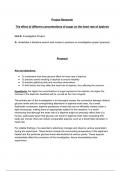Project Research
The effect of different concentrations of sugar on the heart rate of daphnia
Unit 6: Investigative Project
A: Undertake a literature search and review to produce an investigative project proposal
Proposal
Aim and objectives:
● To understand How does glucose affect the heart rate of daphnia
● To practise careful handling of daphnia to ensure reliability
● To practise gathering data and recording observations
● To limit factors that may affect the heart rate of daphnia, thus affecting the outcome.
Hypothesis: the higher the concentrations of sugar exposed to the daphnia, the higher the
increase in the daphnia's heartbeat will be, as well as the more irregular.
The primary aim of this investigation is to thoroughly assess the connection between distinct
glucose levels and the corresponding alterations in daphnia heart rates. As a small,
freshwater crustacean, daphnia possesses a heart that can be efficiently viewed under a
light microscope, making them an appropriate subject for this research. It is worth
mentioning that although the heart rate of a daphnia might not precisely reflect that of a
human, particularly given that glucose can result in daphnia heart rates exceeding 250
beats per minute, there are certain comparable aspects, such as a discernible elevation in
heart rate.
For reliable findings, it is essential to attentively manage and observe various parameters
during the experiment. These factors include the surrounding temperature of the daphnia's
habitat and the particular glucose levels administered at various points. These aspects
substantially affect the conclusion of the investigation, hence necessitating close
supervision.
, A key benefit of employing daphnia in this research is their transparent quality, enabling
effortless, non-destructive monitoring of the heartbeat, negating the need for dissection.
This level of transparency also allows for real-time gathering of data concerning the heart
rate and its variations in response to different glucose levels.
Current studies on this topic indicate that glucose significantly impacts the daphnia's
nervous system, ultimately resulting in a heightened heart rate. As such, our comprehensive
examination and evaluation of these influences may aid in uncovering potential similarities
and essential biological concepts that may apply to human heart rate control concerning
glucose concentrations.
Literature findings
Reference 1- Sim, A. Y., Filippov, V., & Anderson, E. B. (2019). Sugar and the heart: The sweet
heart truth. Cardiovascular Research, 115(11), 1557-1569. doi: 10.1093/cvr/cvz101.
The reference article titled "Sugar and the heart: The sweet heart truth" by Sim et al., published
in the well-respected journal Cardiovascular Research, is a peer-reviewed study. The authors,
having affiliations with the University of California, San Francisco, and the University of
California, San Diego, possess relevant academic credentials, indicating the study's reliability
and accuracy.
Cardiovascular Research has a high impact factor (as of 2020, it is 8.247) and is ranked within
the top 10 of all cardiovascular journals worldwide by the Clarivate Journal Citation Reports. A
high impact factor demonstrates the journal's influence, importance, and relevance within the
field of cardiovascular research. As well as this, Cardiovascular Research is published by
Oxford University Press, a respected academic publisher known for its stringent review process,
ensuring that only high-quality research is published.
The authors are affiliated with well-known research institutions - the University of California, San
Francisco, and the University of California, San Diego. These institutions have a strong
reputation in the field of biomedical research and have produced numerous influential works in
various disciplines, including cardiovascular health.




